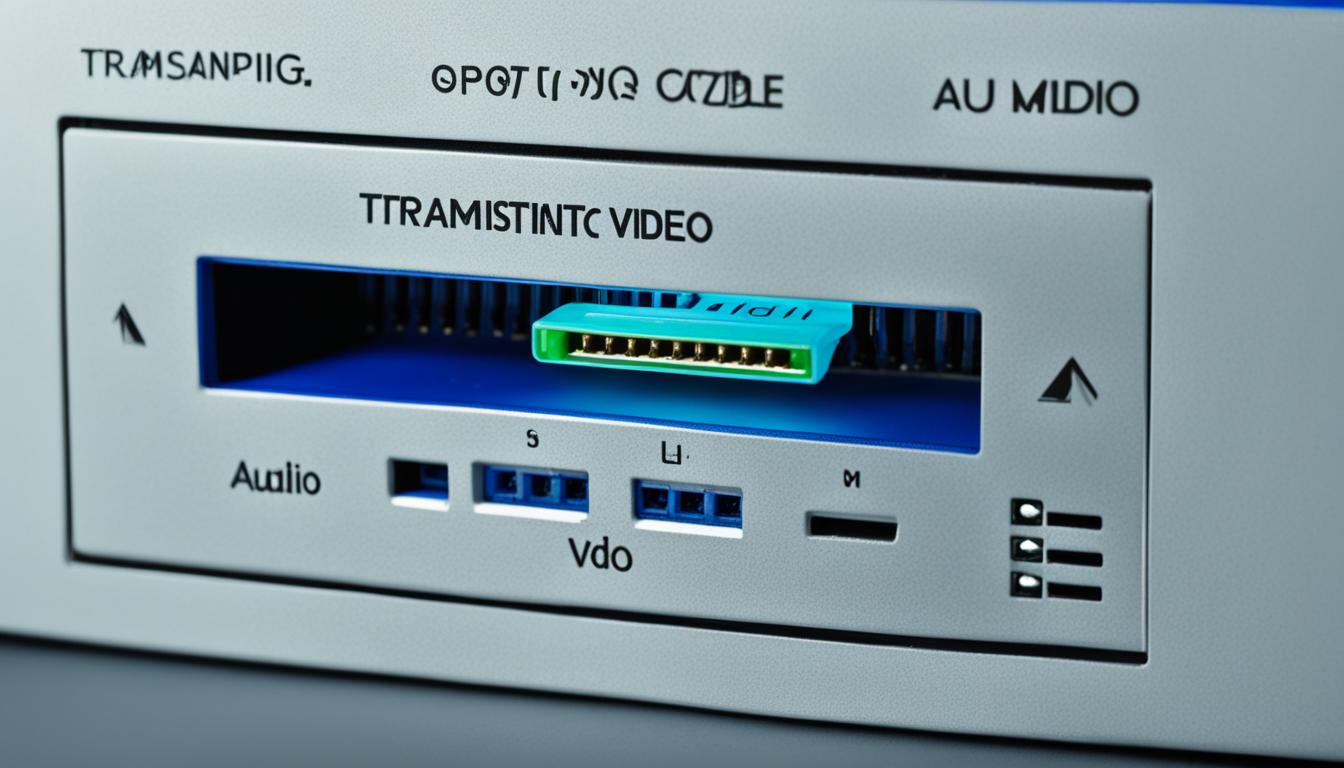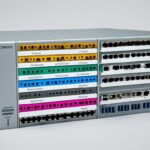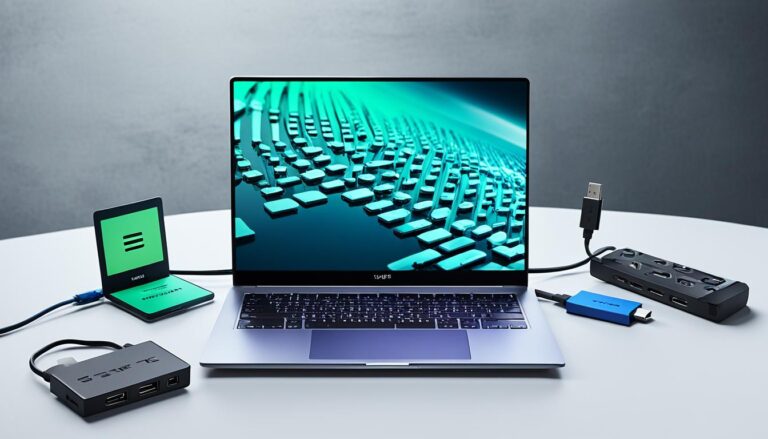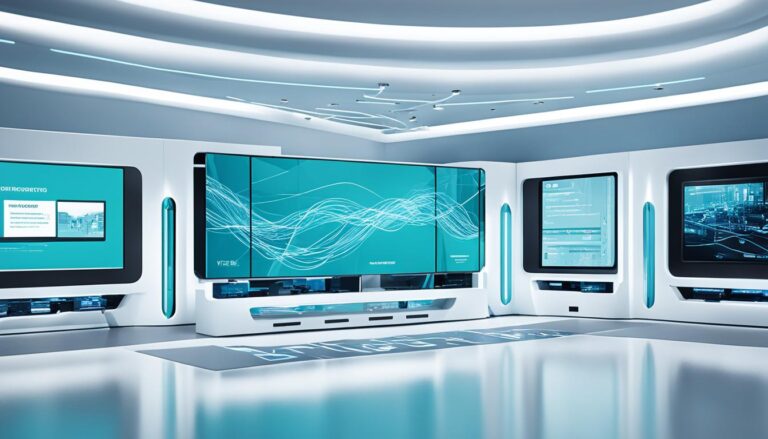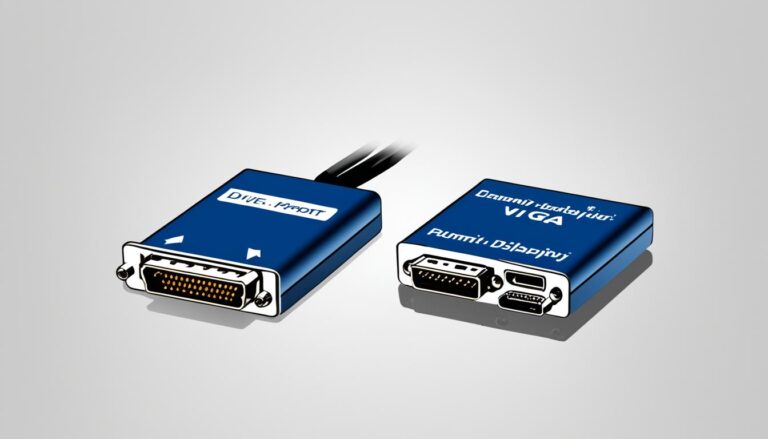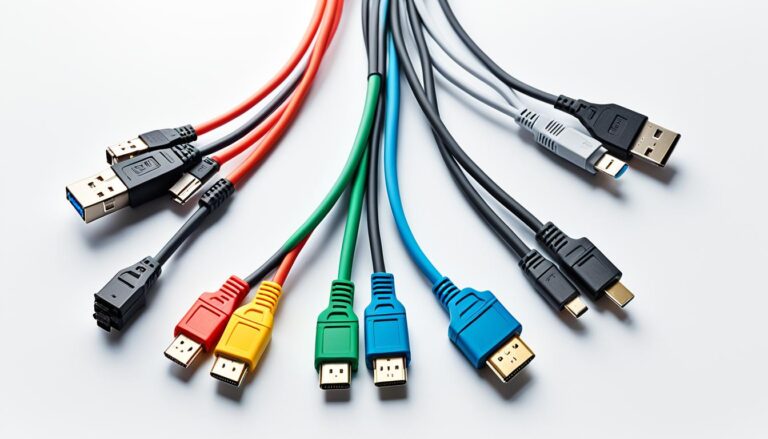In today’s world, it’s vital to connect multimedia correctly. Whether it’s speakers, a gaming setup, or a high-definition screen, choosing the correct computer port is key. This guide will cover various computer ports. These allow the smooth flow of audio and video signals.
Types of Video Input Connectors
The first step to linking your audio and video devices to your computer is knowing the different connectors. Each connector type is crucial for smooth multimedia connectivity. We’ll look at the most common ones and what makes them stand out.
HDMI
HDMI, or High Definition Multimedia Interface, is very popular. It sends both sound and visuals in high quality. TVs, gaming consoles, and Blu-ray players often use HDMI. Its support for various formats and 3D makes HDMI a top choice for entertainment.
DVI
DVI stands for Digital Visual Interface. It’s great for images but doesn’t carry sound. It works with old and new devices. Monitors, projectors, and older graphics cards often have DVI. It’s perfect for detail-rich applications.
DisplayPort
DisplayPort is another versatile connector. It competes with HDMI and is found in newer tech. It supports up to 8K visuals and sound. Its easy-to-connect design adds to its appeal.
VGA
VGA is an older video connector that was once widespread. Being an analog connector, it’s slowly being overtaken by digital ones like HDMI and DisplayPort. VGA appears in older projectors and some computers. Yet, it doesn’t match the performance of newer connectors.
Other Video Input Connectors
Other connectors include USB-C, Thunderbolt, AV (RCA), NDI, and SDI. USB-C is flexible, handling audio, video, data, and power. Thunderbolt excels in high-speed data and video transfers. AV (RCA) is used for analog signals. NDI and SDI are key in professional setups.
Choosing the right video input connector depends on your needs and device compatibility. Knowing the options will help you connect devices effectively for the best audio and video quality.
Now, you know the key video input connectors. You can pick the best one for your needs and enjoy smooth multimedia playback.
See the table below for a quick reference guide to video input connectors:
| Connector | Use | Compatibility | Features |
|---|---|---|---|
| HDMI | Home entertainment devices, gaming consoles, Blu-ray players | Wide range of devices | High resolutions, 3D support, compatibility with various audio and video formats |
| DVI | Computer monitors, projectors, older graphics cards | Devices with DVI ports | High resolutions, analog and digital support |
| DisplayPort | Modern computers, AV components | Devices with DisplayPort or USB-C ports | High resolutions, audio transmission, reversible orientation |
| VGA | Older devices, projectors, some desktop computers | Devices with VGA ports | Analog support |
| USB-C | Wide range of devices, including laptops and smartphones | Devices with USB-C ports | Audio, video, data, and power transmission |
| Thunderbolt | High-speed data transfer, multiple video outputs | Devices with Thunderbolt ports | Powerful connectivity options |
| AV (RCA) | Analogue audio and video signals | Devices with AV (RCA) ports | Compatible with older devices |
| NDI | Professional broadcast and production setups | NDI-compatible devices and software | High-quality video over IP networks |
| SDI | Professional broadcast and production setups | SDI-compatible devices and software | Uncompressed, low-latency video transmission |
With this information, you’re set to pick the right video input connector. This ensures you get the best compatibility and performance.
VGA – The Legacy Video Connector
VGA, or Video Graphics Array, is an old type of video connector. It was often used in older technology. Some devices like home players and projectors still have it. But, VGA is getting rarer because new digital connectors give better pictures and more features.
VGA was a common choice for linking screens to computers. It uses 15 pins to send video, giving a top quality of 640×480 pixels. But VGA can’t match today’s needs for quality and has become less popular.
Now, HDMI and DisplayPort are the top picks for video connectors. They send clearer images, support higher quality, and can also carry sound. This makes them better for today’s multimedia needs.
VGA isn’t gone, though. It’s still found in some older equipment. You can use adapters to connect VGA devices to modern screens. But for the best quality and performance, moving to digital connectors is a smart move.
VGA shows how video connections have grown over time. As tech moves forward, knowing about and picking the right video connectors is key.
| Video Connector | Image Quality | Audio Support | Maximum Resolution |
|---|---|---|---|
| VGA | Good | No | 640×480 pixels |
| HDMI | Excellent | Yes | Varies (up to 10K) |
| DisplayPort | Excellent | Yes | Varies (up to 16K) |
DVI – Digital Visual Interface
DVI stands for Digital Visual Interface. It’s a type of connection used in computers and screens. Unlike the old VGA port, DVI has become the new standard. It sends clear video signals from one device to another.
DVI is great for displaying sharp, detailed images on screens and projectors. It sends high-quality signals. This means your pictures and videos look very clear.
The Advantages of DVI
“The beauty of DVI lies in its versatility and backward compatibility.” – Technical expert, Jane Thompson
DVI connectors come in two types: single-link and dual-link. Single-link can show up to 1920 x 1200 pixels. Dual-link goes higher, up to 2560 x 1600 pixels.
Interesting fact: DVI was created by the Digital Display Working Group in 1999.
DVI vs. HDMI: A Comparison
HDMI is now very popular, but DVI is still widely used, especially with computers. Let’s see how they differ:
| DVI | HDMI |
|---|---|
| Video-only connector | Transmits both audio and video |
| Analog and digital signal support | Digital signal support only |
| Single-link and dual-link configurations | Single connector for all devices |
| No support for newer features like Ethernet or Audio Return Channel (ARC) | Offers additional features like Ethernet and ARC |
| Used primarily for computer displays and projectors | Commonly found in TVs, gaming consoles, and home theater systems |
The Future of DVI
Technology is always changing. New connections like HDMI and DisplayPort are becoming more common. But DVI still has its place. Many professional and industrial setups still use it.
While HDMI is often chosen for home devices, DVI is still preferred for its high-quality video in many applications.
Now, we will learn about HDMI’s wide use and flexibility in Section 5.
HDMI – The King of Multimedia
In today’s high-definition world, HDMI leads the way in multimedia links. Known as High Definition Multimedia Interface, it has changed how we enjoy audio and video at home.
HDMI connects our devices to our senses, sending sound and pictures flawlessly. This works whether you’re using your TV, Blu-ray player, or a game console. HDMI ensures the best quality sound and visuals.
HDMI is known for its flexibility. It matches a broad range of devices and operates perfectly with the latest high-definition screens. With HDMI, expect incredible visuals and colours that make your entertainment come alive.
But HDMI is more than just top-notch visuals; it’s also about making things easier and performing better. HDMI cables support longer distance connections. This is great for home theaters, where your setup might spread out.
HDMI is amazing at handling high resolutions, like ultra-high-definition (UHD) and 4K. This lets you see movies and shows with amazing detail and clarity. It even supports 3D, for those who love three-dimensional fun.
The sound quality with HDMI is also top-notch. It works with many audio formats, like Dolby TrueHD and DTS-HD. You get an enriching audio experience that matches the amazing visuals.
In conclusion, HDMI deserves its status as the top choice for multimedia connection. It’s perfect for modern entertainment systems, thanks to its easy use, support for 3D and high resolutions, and wide compatibility.
Next, let’s check out DisplayPort, another impressive connector.
DisplayPort – The Versatile Option
DisplayPort is a versatile connector that smoothly sends both audio and video signals. It is as good as HDMI and is found on many modern devices. With top features and great compatibility, DisplayPort is a top choice for a digital display interface.
DisplayPort is great for high-quality images. Whether it’s for graphic work or watching films, it delivers crisp visuals. You get to see all the details in your work or movies.
Not only does DisplayPort give great visuals, but it also carries sound. With just one cable, you can get great audio and video. This is perfect for movies, games, or making your own videos. You don’t need extra cables.
One cool thing about DisplayPort is you can plug it in any way; there’s no wrong way to do it. No more frustration trying to get it plugged in right. This makes setting up your devices quick and easy.
Many professionals and enthusiasts choose DisplayPort for its reliability and how well it works with different devices. It connects smoothly to monitors, laptops, desktops, and projectors. It’s a great option for anyone who loves technology, making videos, or playing games. DisplayPort makes sure you get the best performance and ease of use.
Key Benefits of DisplayPort:
- Support for high resolutions
- Audio transmission capability
- Reversible orientation for easy connection
- Compatibility with a wide range of devices
If you’re looking for a digital display interface that’s top-notch and flexible, DisplayPort is a fantastic choice. It handles both sound and picture, supports high resolutions, and provides a smooth experience. It’s a favourite for connecting multimedia.
USB-C – The All-in-One Connector
USB-C, or Universal Serial Bus Type-C, is a versatile connector that has become very popular. It transmits data, power, audio, and video signals. This makes it a great choice for many devices, providing flexibility and convenience.
This connector is now a common choice for laptops, smartphones, tablets, and more. Its fast transfer speeds and wide compatibility are appreciated. With USB-C, one cable can do it all – connect and charge different gadgets.
USB-C is appreciated for its small size and user-friendly design. It can be plugged in any way, avoiding common mistakes. This has made it a favourite for its simplicity and ease of use.
Looking ahead, USB-C is set to be a key player in connectivity. It’s great for transferring files, connecting screens, or charging up. USB-C stands out for its versatility and efficiency in our digital world.
Conclusion
When you need to choose a port for your audio and video devices, it really depends on what you need. VGA and DVI are older types and not used much in new tech because they are analog. On the other hand, HDMI, DisplayPort, and USB-C offer more modern features.
HDMI is perfect for high-quality video and sound in home cinemas. It works with lots of devices and gives brilliant playback. DisplayPort is great for new computers and devices, offering top resolutions and sound. USB-C is an all-rounder, allowing quick data transfer, charging, and media connections.
To make sure you get the best out of your devices, pick the right port. This is key whether connecting a TV, computer, console, or other gadgets. Knowing about different ports helps you choose wisely. Join the digital age and get the most from your audio and video experiences with the newest ports.
FAQ
Which computer port transmits audio and video signals?
Many computer ports can send audio and video. These include HDMI, DVI, DisplayPort, and VGA. USB-C, Thunderbolt, AV (RCA), NDI, and SDI are also capable.
What is VGA?
VGA stands for Video Graphics Array. It’s a legacy video connector found in older systems. It’s an analog connector still used in devices like home players and projectors. VGA is losing popularity as digital connectors offer better quality and features.
What is DVI?
DVI means Digital Visual Interface. It’s a video-only connector that came after VGA for older systems. It transmits analog and digital signals. DVI supports high resolutions. It comes in single-link and dual-link types, the latter supporting higher resolutions.
What is HDMI?
HDMI is High Definition Multimedia Interface. It’s preferred for modern home entertainment. It sends audio and video in digital form. HDMI ensures high-quality playback. It works with TVs, Blu-ray players, and game consoles. HDMI supports long cables, high resolutions, 3D, and various formats.
What is DisplayPort?
DisplayPort is versatile, competing with HDMI on performance. Found on modern computers and AV components, it sends audio and video. DisplayPort supports high resolutions and audio. Its design is reversible, making it user-friendly. It’s chosen for its reliability and flexibility.
What is USB-C?
USB-C stands for Universal Serial Bus Type-C. It’s a powerful, multi-use connector. It transmits data, power, audio, and video. USB-C is becoming essential for laptops and smartphones. It offers quick transfer speeds and works with many interfaces.
